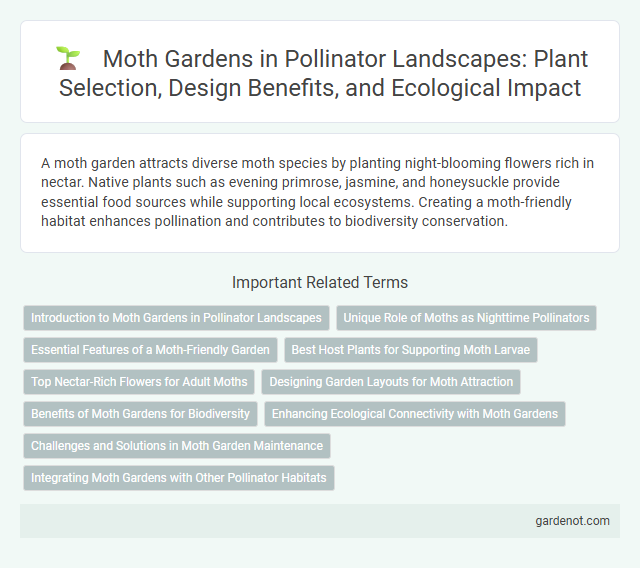A moth garden attracts diverse moth species by planting night-blooming flowers rich in nectar. Native plants such as evening primrose, jasmine, and honeysuckle provide essential food sources while supporting local ecosystems. Creating a moth-friendly habitat enhances pollination and contributes to biodiversity conservation.
Introduction to Moth Gardens in Pollinator Landscapes
Moth gardens play a crucial role in pollinator landscapes by attracting nocturnal pollinators that support biodiversity and ecosystem health. These gardens typically include native night-blooming flowers such as evening primrose and moonflower, which provide nectar and habitat for moth species. Integrating moth gardens enhances pollination during nighttime hours, complementing daytime pollinators like bees and butterflies.
Unique Role of Moths as Nighttime Pollinators
Moth gardens play a crucial role in supporting nighttime pollination, as moths are primary pollinators for many nocturnal plants. Their long proboscises enable them to access deep nectar sources inaccessible to other pollinators, facilitating the reproduction of specialized flowers. Planting a variety of night-blooming species like evening primrose and moonflower enhances biodiversity and sustains essential moth populations.
Essential Features of a Moth-Friendly Garden
A moth-friendly garden requires night-blooming flowers rich in nectar, such as evening primrose and jasmine, to attract nocturnal pollinators. Incorporating native plants and providing shelter through dense foliage or brush piles creates a conducive habitat for moths to rest and reproduce. Minimizing artificial light pollution ensures moths can navigate effectively, enhancing their pollination activities and supporting biodiversity.
Best Host Plants for Supporting Moth Larvae
Planting native species such as Virginia creeper (Parthenocissus quinquefolia), oak trees (Quercus spp.), and willow trees (Salix spp.) provides essential host plants for supporting diverse moth larvae populations. These plants offer critical nourishment and shelter during the larval stage, promoting healthy moth development and benefiting local biodiversity. Incorporating these host plants into a moth garden enhances ecological balance by supporting nocturnal pollinators and their life cycles.
Top Nectar-Rich Flowers for Adult Moths
Top nectar-rich flowers for adult moths include evening primrose, jasmine, and honeysuckle, prized for their strong fragrance and abundant nectar that attract nocturnal pollinators. Moonflower and nicotiana release potent scents at dusk, making them vital for supporting diverse moth populations. Incorporating these plants in a moth garden enhances biodiversity and promotes effective nighttime pollination.
Designing Garden Layouts for Moth Attraction
Designing garden layouts for moth attraction involves selecting night-blooming plants with strong fragrances such as evening primrose, jasmine, and nicotiana, which emit scents that lure moths after dusk. Incorporating layered vegetation with tall trees, shrubs, and low ground cover creates sheltered microhabitats and perching sites essential for moth activity. Positioning light-colored plants near outdoor lighting can enhance visibility for moths while minimizing light pollution that disrupts their natural behaviors.
Benefits of Moth Gardens for Biodiversity
Moth gardens significantly enhance biodiversity by supporting nocturnal pollinators essential for the reproduction of many native plants. These gardens provide habitat and food sources for various moth species, promoting ecosystem balance and genetic diversity. Incorporating moth-attracting plants increases nighttime pollination, benefiting both wild flora and agricultural crops.
Enhancing Ecological Connectivity with Moth Gardens
Moth gardens play a crucial role in enhancing ecological connectivity by providing essential habitats and food sources for nocturnal pollinators, thereby supporting biodiversity and ecosystem resilience. Native plants with night-blooming flowers attract various moth species, facilitating cross-pollination across fragmented landscapes and promoting genetic flow among plant populations. Integrating moth gardens into pollinator networks strengthens habitat corridors, ensuring sustained ecosystem services and wildlife movement.
Challenges and Solutions in Moth Garden Maintenance
Maintaining a moth garden presents challenges such as attracting specific moth species while deterring predators and managing night-blooming plants that require careful hydration to prevent fungal growth. Solutions include planting native night-blooming flowers like evening primrose and tobacco plants to provide nectar, using organic pest control methods, and installing gentle lighting to minimize disruption to moth activity. Regular monitoring and creating a habitat that supports moth larvae and adult moths foster a balanced ecosystem critical for successful moth garden maintenance.
Integrating Moth Gardens with Other Pollinator Habitats
Integrating moth gardens with other pollinator habitats enhances biodiversity and ecosystem resilience by providing continuous nectar sources and shelter throughout different seasons. Combining moth-attracting plants with native wildflowers, bee-friendly shrubs, and butterfly gardens creates a synergistic environment that supports diverse pollinator populations. Strategic placement of host plants for moth larvae near flowering species helps sustain moth life cycles while enriching overall pollinator services in the garden.
Moth garden Infographic

 gardenot.com
gardenot.com